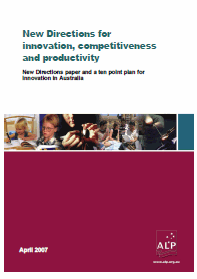|
|
|
|
|
|
|
News & Views item - April 2007 |
![]() Labor to Separate Science from Education and Amalgamate Innovation, Industry,
Science and Research. (April 25, 2007)
Labor to Separate Science from Education and Amalgamate Innovation, Industry,
Science and Research. (April 25, 2007)
 Yesterday the federal Labor opposition released New
Directions for innovation, competitiveness and productivity: a ten point plan
for innovation in Australia and while thin on detail was not entirely
devoid of substance.
Yesterday the federal Labor opposition released New
Directions for innovation, competitiveness and productivity: a ten point plan
for innovation in Australia and while thin on detail was not entirely
devoid of substance.
It makes a point of its intention to restore the Chief Scientist's position to full time, but hasn't said where the Chief Scientist's office will be placed, e.g. in the proposed Department of Innovation, Industry, Science and Research or in the Department of the Prime Minister and Cabinet which is where it ought to be.
On the other hand it makes the promise that Labor will, "provide $111 million
over four years in financial incentives for university students to study and
teach maths and science," and goes on to commit to a "a culture of innovation in
our community, including our schools; by fostering the curiosity of our
children; by encouraging our best and brightest young people to pursue careers
in science, maths, engineering and ICT; and by ensuring that when they do make
such a choice, they receive world class education and training.
"Labor is committed to implementing an education revolution in Australia... Labor understands that healthy universities are critical to a nation’s innovation framework – a great university is a factory of knowledge. Labor is committed to rebuilding the international reputation of Australia’s universities by attracting and retaining the best academics and ensuring they have the facilities and equipment they need to fulfil their role as generators and disseminators of knowledge. Australia’s universities are not keeping pace with those of our international competitors in driving innovation. Labor will reverse this trend by investing in our universities – recognising the importance of research, innovation and knowledge transfer, teaching and community engagement."
But the detail of what is meant is lacking and there are no costings given. Will it, should it attain government, look to short term gain from public investment in the nation's universities and research infrastructure and personnel? So, for example, there continue to be questions asked in the UK as to directions Britain's Chancellor, Gordon Brown, wants to take support for R&D.
The president of the Federation of Australian Scientific and Technological Societies (FASTS), Tom Spurling in a statement released yesterday said, "[T]he paper tends to play down the role of formal R&D and the proposal to establish 10 innovation centres [at the cost of $200 million over four years] does not seem a particularly promising way to provide agile and effective linkages between industry, universities and other public sector research or science agencies. Nevertheless, Labor’s paper is a constructive contribution that will help bring greater focus to a policy area that has been allowed to drift since Backing Australia’s Ability was implemented in 2001."
Another matter not mentioned in this latest "New Directions" paper is how Labor would, were it in power, reshape the Coalition's Research Quality Framework which increasingly gives the appearance of a vast boondoggle to employ bureaucrats while keeping researchers from doing what they ought to be doing.